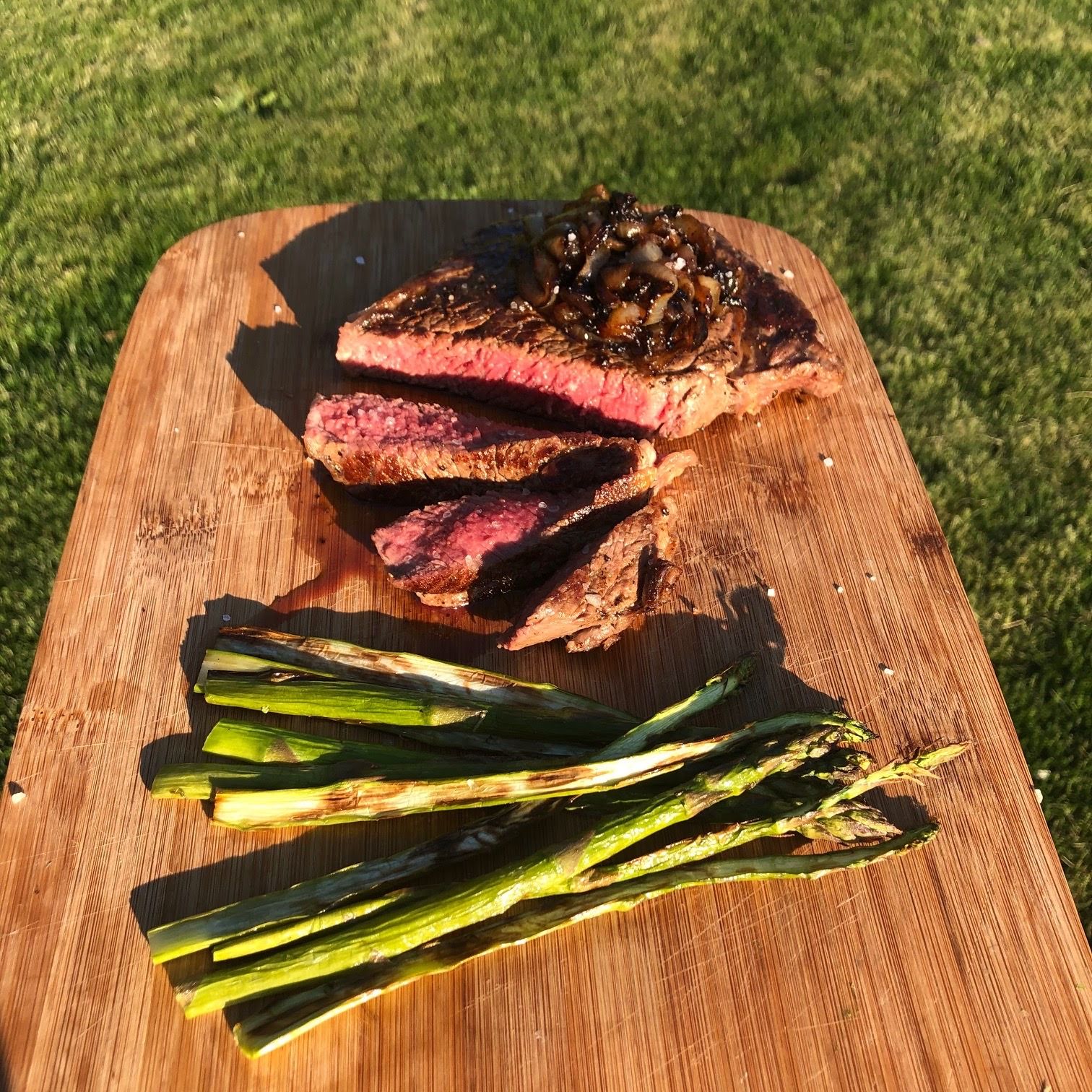Written by Grace Goodrich. Graphic by Sophie Levy.
Food, like water, bears memory. Summer family dinners in the driveway. The grill going out back, my mother tending rice pilaf, boiled corn on the cob, and asparagus in our tiny parlor kitchen. Dad hunched over the hot coals, so precarious and anxious in his approach that he always cooked our steaks a minute past medium— an abomination, I know. I didn’t know any different, then. Deliciously charred and bashfully pink through the middle; every bite loaded with A.1. sauce. Embers in the air, a mirage around the grill that would later become our campfire. Grass and crumbling tar between my calloused summer toes, my skin still burning with daylight, and the breeze that blew through at sunset turning sweat to dew drops on the nape of my neck. We ate cubed watermelon for our first dessert and toasted marshmallows for our second. Wholesome. Simple. Treasured. We didn’t have much space, much money, much time. But the production, the heart— so memorable. These dinners were our family opus.
There is an elusive and spontaneous thread that joins our memory for time and place to sensual experience. Tastes give birth to nostalgia. I grew up witnessing my mother producing bounty from little. She was a committed coupon clipper, thrifty grocery shopper, and ingenious pantry chef. Until her recent passing, she would grace us with long text messages describing in detail the dishes she managed to create from what was soon to expire in the cupboard or fridge. I was always moved by these notes. They evoked my resemblance to her, our shared attention to detail and to our cooking lineage.
My mother was Portuguese. Her mother and grandmother immigrated into Pawtucket, Rhode Island in the 1930s from Alcobaça, Portugal. I grew up hearing stories of my mother’s vovo, a true renaissance woman. She grew grape vines in the backyard for her own wine, raised chickens in the basement, and turned nearly every inch of the small yard of their three family home in Hartford, Connecticut into garden space. She kept rabbits, which my mother would feed until they’d disappear and reappear as “chicken” stew. She’d call the family down to her first floor apartment, by banging her ladle on the water pipe. I never met my great grandmother, but she feels alive within me, as does my mother. My mother gave me her memories, painting me these pictures. And in our shared lifetime, we made such memories of our own.
Food has always felt like a communion to me. A coming home. Every dish a ceremony, no matter its simplicity. Cereal and milk: late night snacks and childhood mornings. Chocolate Chip Cookies: the way I say “I love you.” Bone broth: heals the gut. Oysters: the perfect “fuck me” treat. Salads: workday lunches when you’ve got your shit together. Egg and cheese on a bodega roll: your hangover cure-all. And steak. Summer nights in the backyard steak. Red lip and a good book at the bar date nights with yourself steak. At home and on a budget steak. Sea salt on steak. Scraps for your pup steak. Cooking for your boo for the first time steak. Bring your own steak.
Period steak.
We were young enough to believe that indulgence was a way of saying “I’m doing alright.” Our little Brooklyn sisterhood; all twenty somethings, all creatives, all hustling. When the moon called and our wombs shed, we’d howl for one another: “Hey, babes. Period steaks?” And we would make plans to gather at Five Leaves, our favorite Greenpoint bistro.
These dinners were coven ceremonies. Sisterhood of the steak. Once a month, sometimes twice. A medium rare bloody delicacy that depleted our wallets and fortified us with iron. We bled together, wailed together, ate together. Our server, a smoking hot Australian in a colorful Hawaiian shirt and doubly adorable Loren denim apron who we knew by name, would place a juicy hanger below our noses. Accompanied by beds of mixed green and truffled frites with aioli. We’d split a bottle of red, something frugal. And with cappuccinos for night caps, we’d tuck each other in for the remainder of our cycles.
After all, food is about relationships: to people, to place, to time. Though we are displaced, physically, emotionally and mentally by this pandemic, we may look to our memories and traditions for comfort. And forge new ceremonies— in our kitchens. Confusion and worry dominate much of our head and heart space, now. But we can carry the little indulgences and delicacies that ground us into this newfangled landscape. We can give them new times and new places.
These days call for ingenuity, they call for resilience. We are, undoubtedly, going to discover nostalgias we didn’t know we had during this period of stillness. And it is important to take part in celebrations for yourself. A steak dinner is a fucking party. And an accessible one, at that. It loses none of its decadence when cooked at home. It is still special. It is tender and rich. And it will, especially when cooked for one, put you to bed. It is my hope that it does, with dreams of summer time dinners out back, the comforts of what was, and the excitement of what could be.
Cast-Iron Skillet Steak

About 1 hour · Serves 1-2
Ingredients
One boneless beef steak (1 inch thick, 2-3 lbs)
Coarse sea salt
Black pepper (to taste)
Method
- Pat meat dry with paper towels. Set aside to bring to room temperature.
- Sprinkle sea salt into bottom of cast-iron skillet, lightly coating the entire surface.
- Heat skillet on high until pan is smokin’, about five minutes.
- Place steak into smoking skillet. Sear for one minute, flip over.
- Move steak around in skillet to gather all that salt, adding more if desired (I always add more!). Sear edges of meat against the sides of the pan. After one minute of this dance, flip again.
- Continue to flip every thirty seconds or so, until steak is browned on the outside and tender to touch (not squishy). For perfect medium-rare temperature, the meat should feel like the intrinsic muscle between your thumb and wrist, when touching your thumb to your pointer finger.
- Remove steak from the skillet and place on a cutting board. Allow to sit for a few minutes to lock in its juices.
- Serve sliced, topped with quick-caramelized shoyu onions, and a “Salt Bae” sprinkle of sea salt flakes.
Quick-Caramelized Shoyu Onions
About 45 minutes · Serves 1-2
Ingredients
One medium sized yellow onion
2 tbsp salted butter
Shoyu (a dash)
Black pepper
Method
- Halve your onion lengthwise.
- Peel and discard the light brown husk layers of onion.
- Remove the very top and root base off each half and slice remaining onion halves into strips about one centimeter thick.
- Melt two tablespoons of salted butter in a small cast-iron (preferred) or non-stick pan on medium-high heat.
- Add sliced onion to pan and give a toss to coat onions in butter.
- Continue to cook giving a quick turn through every so often. As edges of onions start to blacken, turn heat to low.
- Add black pepper to preferred taste.
- Cook on low until onions are nearly translucent. Add a dash of shoyu. Toss onions in simmering shoyu and cook for several more minutes. No shoyu on hand? Add your favorite tamari, soy, or worcestershire sauce.
- Cook down onions an additional minute, turn off heat and set aside.
- Top your steak with onions before serving.
Roasted Asparagus Spears
About 15 minutes · Serves 1-2
Ingredients
A bunch of green asparagus (8-10 spears)
Extra virgin olive oil
A Lemon
Sea salt flakes
Black pepper
Method
- Preheat the oven to 400 degrees Fahrenheit.
- Rinse and pat dry asparagus.
- Slice the bottom two inches or so off the asparagus. Note: You can tell where to trim spears based on the color change at the bottom; cut where it ceases to be green and discard trimmings.
- Slice each asparagus spear in half lengthwise.
- Using a pastry brush (or fingers), coat each asparagus in a light layer of olive oil. Lay atop the baking sheet, cut side down.
- Halve your lemon and squeeze lemon juice over the spears (remove any lemon seeds that may escape your grasp) sprinkle with sea salt flakes and black pepper.
- Place in your preheated oven and roast for about 5-8 minutes until bright green and snappy. No one likes overcooked asparagus.
- Remove from oven when done.
- Serve alongside your steak and onions.
Check LONYC weekly our take on: food, fashion, film, photography, politics, music and creative writing. Follow us, feel the vibe @laidoffny.
Get to know Grace better, @la_aguila for all her latest culinary endeavours.
For more thought provoking graphics check out @art_by_slevy.



